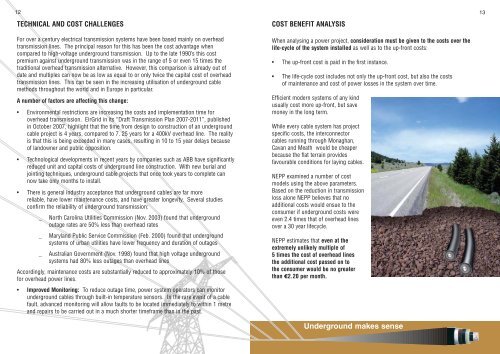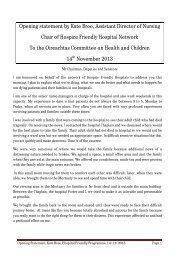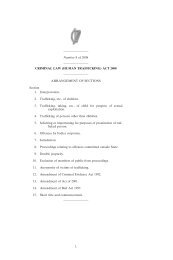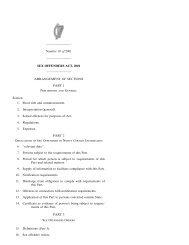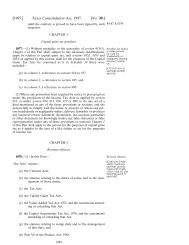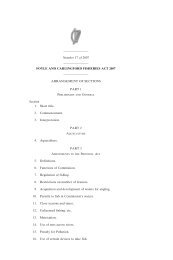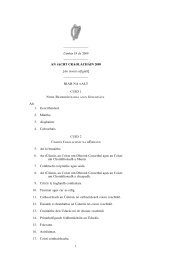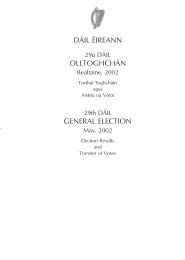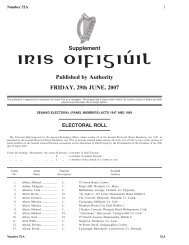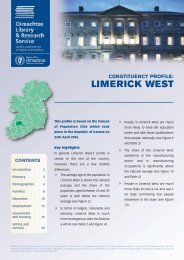north east pylon pressure
north east pylon pressure
north east pylon pressure
You also want an ePaper? Increase the reach of your titles
YUMPU automatically turns print PDFs into web optimized ePapers that Google loves.
12<br />
TECHNICAL AND COST CHALLENGES<br />
For over a century electrical transmission systems have been based mainly on overhead<br />
transmission lines. The principal reason for this has been the cost advantage when<br />
compared to high-voltage underground transmission. Up to the late 1990’s this cost<br />
premium against underground transmission was in the range of 5 or even 15 times the<br />
traditional overhead transmission alternative. However, this comparison is already out of<br />
date and multiples can now be as low as equal to or only twice the capital cost of overhead<br />
transmission lines. This can be seen in the increasing utilisation of underground cable<br />
methods throughout the world and in Europe in particular.<br />
A number of factors are affecting this change:<br />
• Environmental restrictions are increasing the costs and implementation time for<br />
overhead transmission. EirGrid in its “Draft Transmission Plan 2007-2011”, published<br />
in October 2007, highlight that the time from design to construction of an underground<br />
cable project is 4 years, compared to 7. 25 years for a 400kV overhead line. The reality<br />
is that this is being exceeded in many cases, resulting in 10 to 15 year delays because<br />
of landowner and public opposition.<br />
• Technological developments in recent years by companies such as ABB have significantly<br />
reduced unit and capital costs of underground line construction. With new burial and<br />
jointing techniques, underground cable projects that once took years to complete can<br />
now take only months to install.<br />
• There is general industry acceptance that underground cables are far more<br />
reliable, have lower maintenance costs, and have greater longevity. Several studies<br />
confirm the reliability of underground transmission:<br />
_ North Carolina Utilities Commission (Nov. 2003) found that underground<br />
outage rates are 50% less than overhead rates<br />
_ Maryland Public Service Commission (Feb. 2000) found that underground<br />
systems of urban utilities have lower frequency and duration of outages<br />
_ Australian Government (Nov. 1998) found that high voltage underground<br />
systems had 80% less outages than overhead lines<br />
Accordingly, maintenance costs are substantially reduced to approximately 10% of those<br />
for overhead power lines.<br />
• Improved Monitoring: To reduce outage time, power system operators can monitor<br />
underground cables through built-in temperature sensors. In the rare event of a cable<br />
fault, advanced monitoring will allow faults to be located immediately to within 1 metre<br />
and repairs to be carried out in a much shorter timeframe than in the past.<br />
COST BENEFIT ANALYSIS<br />
When analysing a power project, consideration must be given to the costs over the<br />
life-cycle of the system installed as well as to the up-front costs:<br />
• The up-front cost is paid in the first instance.<br />
• The life-cycle cost includes not only the up-front cost, but also the costs<br />
of maintenance and cost of power losses in the system over time.<br />
Efficient modern systems of any kind<br />
usually cost more up-front, but save<br />
money in the long term.<br />
While every cable system has project<br />
specific costs, the interconnector<br />
cables running through Monaghan,<br />
Cavan and Meath would be cheaper<br />
because the flat terrain provides<br />
favourable conditions for laying cables.<br />
NEPP examined a number of cost<br />
models using the above parameters.<br />
Based on the reduction in transmission<br />
loss alone NEPP believes that no<br />
additional costs would ensue to the<br />
consumer if underground costs were<br />
even 2.4 times that of overhead lines<br />
over a 30 year lifecycle.<br />
NEPP estimates that even at the<br />
extremely unlikely multiple of<br />
5 times the cost of overhead lines<br />
the additional cost passed on to<br />
the consumer would be no greater<br />
than €2.20 per month.<br />
Underground makes sense<br />
13


